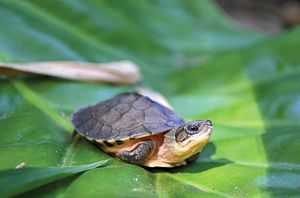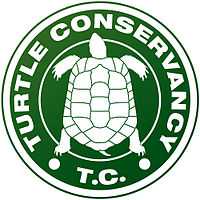Turtle Conservancy
|
The Turtle Conservancy is dedicated to protecting the most endangered turtles
and tortoises and their habitats worldwide. | |
| Conservation & Habitat Preservation | |
| Industry | Nonprofit Organization |
| Founder | Eric Goode, Maurice Rodrigues |
| Headquarters |
49 Bleecker Street, Suite 601 New York, New York 10012 United States |
| Website |
www |
The Turtle Conservancy (TC) is a 501(c)3 organization dedicated to protecting the most endangered turtles and tortoises and their habitats worldwide. The Turtle Conservancy's Behler Chelonian Center is the premiere facility for breeding Critically Endangered turtles and tortoises in the United States. Since 2005 the TC has combined this breeding program with conservation efforts in the wild.[1]
Vision
The Turtle Conservancy (TC) is the most comprehensive turtle and tortoise organization in the world protecting all forms of living chelonians including tortoises, freshwater, and marine turtles. The Turtle Conservancy’s work encompasses three programmatic areas: in-range species and habitat preservation and conservation, captive assurance colonies and breeding programs, and a global awareness and education campaign.
The TC is committed to promoting in situ conservation and field research of threatened and endangered chelonians globally. Its work includes protection of species in their natural habitat, education about conservation, and field-based research. It campaigns for conservation legislation, re-evaluation of species’ status in the wild, and development of comprehensive protection strategies for turtles and tortoises.The TC has supported projects on the ground to protect endangered turtles and tortoises in China,[2] Guyana, India, Mexico, Madagascar, Nicaragua, Pakistan, South Africa, and the United States, and has conducted fieldwork around the world, particularly in Southeast Asia, investigating the turtle and tortoise trade.[3] In South Africa, the TC has partnered with the Cape Province wildlife agency Cape Nature and well-known turtle biologist Dr. Margaretha Hofmeyr[4] on two projects related to the Critically Endangered Geometric Tortoise (Psammobates geometricus).
The Turtle Conservancy's Behler Chelonian Center runs an ex situ breeding program for endangered chelonians.[5][6] The organization breeds more individuals from endangered taxa. Its captive breeding center currently manages assurance colonies representing over 1/3 of the world’s most Critically Endangered turtle and tortoise taxa. In addition, the Turtle Conservancy is one of the few institutions that have had success breeding a variety of species including the Chaco Tortoise (Chelonoidis chilensis), Parrot-beaked Padloper (Homopus areolatus), Speckled Padloper (Homopus signatus), Assam Roofed Turtle (Pangshura sylhetensis), Okinawa Leaf Turtle (Geoemyda japonica), and the Impressed Tortoise (Manouria impressa).[7]
Programs
In-Range Species and Habitat Preservation and Conservation
The Turtle Conservancy’s in-country conservation strategies include habitat protection, restoration and stewardship, turtle and tortoise reintroduction and a fieldwork grant program. In South Africa the Turtle Conservancy owns and stewards 237 acres of land in the last remaining habitat for the critically endangered Geometric Tortoise in South Africa. This land is critical habitat needed to save this beautiful tortoise from extinction. In Mexico the Turtle Conservancy is working to protect 43,000 acres[8] of what is believed to be the last stronghold for the Bolson Tortoise, the largest terrestrial reptile in North America. In Madagascar the Turtle Conservancy collaborates Durrell Wildlife Conservation Trust in protecting the Ploughshare Tortoise from extinction. The Turtle Conservancy engages in education of communities and animal marking to eliminate the illegal poaching of Ploughshare Tortoises. In addition, the Turtle Conservancy is a leading member of the International Ploughshare or Angonoka Working Group, which sets direction for Ploughshare Conservation worldwide.[9] The Turtle Conservancy also support Field work in Nicaragua, Mexico, Guyana, Pakistan, India, the Philippines, Namibia, Indonesia, China, and Myanmar.
Captive Assurance Colonies and Breeding Programs
In Southern California the Turtle Conservancy’s Breeding Center breeds more Critically Endangered and Endangered turtles and tortoises than any other institution in the world. It manage 15 of the world’s 40 most critically endangered species. The Turtle Conservancy was the First organization ever to send critically endangered captive bred turtles back to their native range country to participate in a reintroduction program when we repatriated Golden Coin Turtles to China in January of 2013.[10] The Turtle Conservancy produces more Critically Endangered Burmese Star Tortoises than any other institution outside of Burma and is paving the way to send this ecologically extinct species back to their homeland. Over 33 different species are kept at the Turtle Conservancy breeding center where husbandry expertise is both learned and taught to students from all over the world. The Turtle Conservancy breeding center was the First institution to breed a number of endangered species including the enigmatic and endangered Impressed Tortoise and the rarely seen Assam Roofed Turtle.
Behler Chelonian Center
The Behler Chelonian Center is a five acre, AZA-Certified zoological facility founded in 2005, upon the request of John L. Behler (1943-2006), the international turtle conservationist and then Curator of Herpetology at the Bronx Zoo, to provide a home for Wildlife Conservation Society’s (WCS) established chelonian assurance colony. These original 130 tortoises were personally escorted by Turtle Conservancy (TC) staff across the country from St. Catherine’s Island, Georgia to BCC's new facility in southern California.[11] The group included founder animals of the Radiated Tortoise (Astrochelys radiata) Species Survival Plan and the first recorded hatchling Spider Tortoises (Pyxis arachnoides) in the US. Most of these animals remain active in the BCC breeding program today.[12]
Trade Monitoring and Interdiction
The global trade in turtles and tortoises for food, traditional medicine, and pets is the most serious threat to many turtles and tortoises. Unfortunately poaching and the trade can cause extinction even where there is still ample habitat. The Turtle Conservancy works with TRAFFIC, the international wildlife trade monitoring group, and with governments to help arrest smugglers and provide care for confiscated animals. Global Awareness and Education With the hope of inspiring a global groundswell of conservation action to save the world’s turtles and tortoises, the Turtle Conservancy uses media and education in its ongoing Turtles in Crisis awareness camp3aign. The Turtle Conservancy shines a spotlight on the global turtle crisis through a comprehensive and ongoing global media campaign. Since its inception, many millions of people have heard the message. Scientific and international media outlets including CBS 60 Minutes, PBS Charlie Rose, The New Yorker, the Wall Street Journal, the New York Times, the Los Angeles Times, and National Public Radio have profiled the Turtle Conservancy. [13] [14]
Important Dates
2007
| The Ploughshare Tortoise or Angonoka (Astrochelys yniphora) is now one of the most endangered reptiles on the planet. |
Turtle Conservancy began a collaborative effort - along with assistance from the Andrew Sabin Family foundation, Josiah T. Austin, and the Desert Tortoise Council – of acquiring 11,861 acres of land in the state of Durango, Mexico. Located in the Chihuahuan Desert, this land is noted for being prime habitat of Bolson Tortoise (Gopherus flavomarginatus), as well as other species of plants and animals essential to maintaining the biodiversity of the area. The goal of this project is to preserve the largest intact population of Bolson Tortoise remaining, and would be functioning as a long-term re-introduction plan with the Turner Endangered Species Fund and the Fundacion de la Tortuga Grande. Founder Eric Goode traveled to Madagascar to meet with Durrell Wildlife Conservation Trust (DWCT) to discuss the status of the Critically Endangered Ploughshare Tortoise (Astrochelys yniphora). The following year, the IUCN held a Red List workshop in Madagascar to reclassify the endemic IUCN listed species, at which the Turtle Conservancy attended and assisted in drafting an Action Plan for Radiated Tortoise (Astrochelys radiata), Flat-tailed Tortoise (Pyxis planicauda), Madagascar Big-headed Turtle (Erymnochelys madagascariensis), and the Critically Endangered Ploughshare Tortoise (Astrochelys yniphora).[15]
2011
The Turtle Conservancy was awarded a second U.S. Fish and Wildlife matching grant of $25,000. These funds were allocated towards supporting village patrols to identify illegal trade, establishing a field station in Beaboaly, Madagascar, and working with the government of Madagascar in the formation of laws for the protection of the Ploughshare Tortoise.[16]
 |
2013
The TC returned five Critically Endangered Golden Coin Turtles (Cuora trifasciata) hatched at the TC back to their native land in Hong Kong.[17] This historic accomplishment represents the first repatriation of captive-bred turtles from the U.S. to a native country. With the Durrell Wildlife Conservation Trust[18] and Thai Professor and Veterinarian Dr. Nantarika Chansue, the TC completed an emergency rescue effort to provide proper care and management for a large confiscation of Critically Endangered Ploughshare Tortoises recovered by authorities in Bangkok.[19]
Turtle Ball
The Turtle Ball is the Turtle Conservancy's annual benefit.[20] The event’s live and silent auctions [21] feature fine artworks from various artists, and the proceeds go to support the Turtle Conservancy’s work to protect turtles and tortoises around the world.[22]
References
- ↑ Finnegan, William (23 January 2012). "SLOW AND STEADY". THE NEW YORKER: 56–65.
- ↑ Knott, Kylie. "Rare Turtles Sent To Hong Kong". South China Morning Post. Retrieved May 13, 2013.
- ↑ Hance, Jeremy. "Over". The Guardian. Retrieved March 23, 2013.
- ↑ Turtle biologist Dr. Margaretha Hofmeyr http://www.bcb.uwc.ac.za/staff/rhofmeyr.asp
- ↑ Kiester, Ross; Peter Praschag (August 2009). "2008-2009 Bechler Chelonian Center and Turtle Conservancy Report". TSA Turtle Survival Alliance: 24.
- ↑ Rodrigues, Maurice (August 2008). "BBC Report notable Achievements". Turtle Survival Alliance: 18.
- ↑ Gibbons, Paul; Kiester (2013). "Ross". The Tortoise. ISSN 2167-2539 1 (2): 16–26.
- ↑ http://www.turtleconservancy.org/projects/bolson-tortoise-report-web.pdf
- ↑ http://www.turtleconservancy.org/projects/ploughshare-tortoise-report-web.pdf
- ↑ http://usa.chinadaily.com.cn/epaper/2013-03/15/content_16311363.htm
- ↑ Hillard, Gloria (February 27, 2014) "To Save Endangered Tortoises, Conservationists Deface Their Shells" National Public Radio
- ↑ Gibbons, Paul M (2012). The Tortoise 1 (1): 71–81. Missing or empty
|title=(help); - ↑ http://www.cbsnews.com/news/the-race-to-save-the-tortoise-07-01-2013/
- ↑ http://www.bloomberg.com/video/eric-goode-on-the-turtle-conservancy-lb33LFO7TlGSiEn1TkakNA.html
- ↑ Platt, John R (May 8, 2013). "How Poacher Stole 10% of an Entire Tortoise Species...and What Happened Next". SCIENTIFIC AMERICAN. Retrieved May 8, 2013.
- ↑ Akst, Jef (April 1, 2012). "Marked For Life". The Scientist. Retrieved April 1, 2012.
- ↑ Staff, Writer (February 2013). "The majestic Golden Coin turtle has gone home to its native Hong Kong". WILDLIFE EXTRA. Retrieved February 2013.
- ↑ Durrell Wildlife Conservation Trust http://www.durrell.org
- ↑ M, K (June 20, 2013). "Slow Demis". The Economist. Retrieved June 20, 2013.
- ↑ Morris, Bob (February 6, 2013). "Guests With A Hard Shell". The New York Times. Retrieved February 6, 2013.
- ↑ "The First Annual Turtle Ball". VANITYFAIR. Retrieved June 2013.
- ↑ Norris, Louise (April 2012). "The Turtle Conservancy". Muse Magazine (#31).
